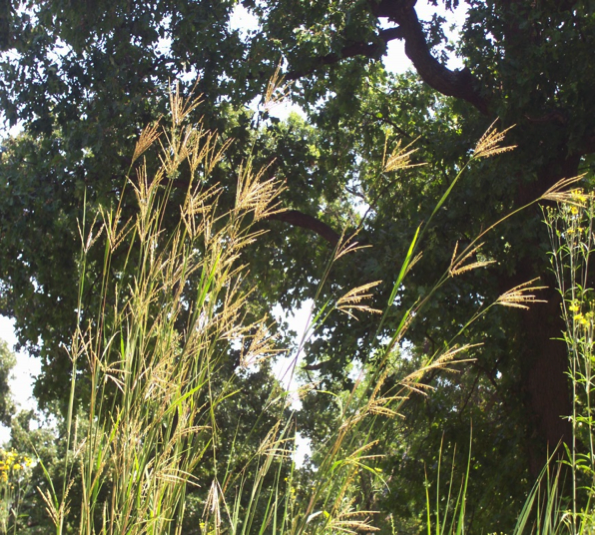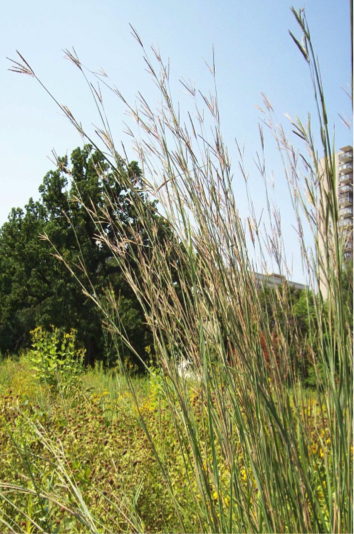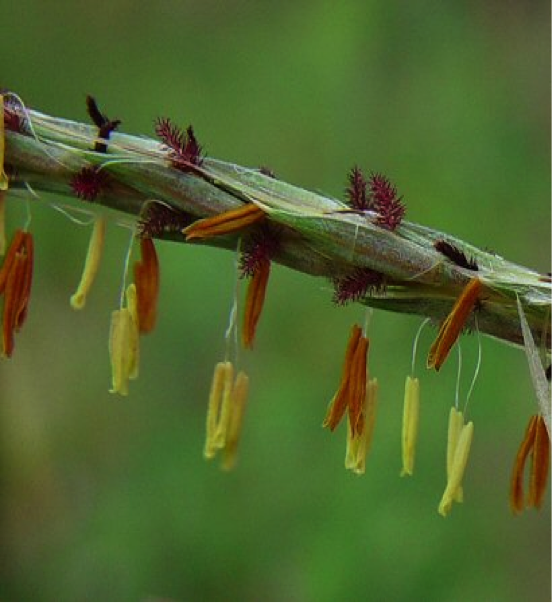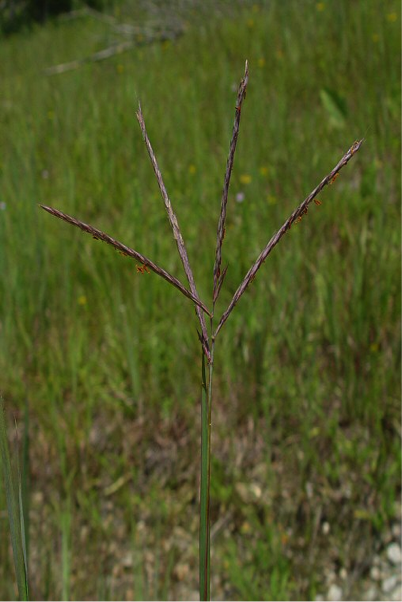Species of the Month, August 2014: Big Bluestem
Note: This is the eighth post in our "Species of the Month" series, written by Park Ecologist Peter VanLinn. It's one of several 2014 initiatives meant to share knowledge we have about the Park with those who love it.
As you visit the natural areas of Forest Park, it is easy to notice the wonderful swaths of purple, yellow, pink and blue from our summer wildflowers. One thing that might get overlooked are some of our flowering grasses.
Though many grasses have relatively inconspicuous flowers, some of them are a little more noticeable. Big Bluestem is one of those more noticeable grasses. Not just because of the intriguing bloom, but also because of the size and color of this native warm-season grass.
Once you see the Big Bluestem with its flowering spikelike racemes in their distinguishable “turkeyfoot” shape, it will be hard to miss or mistake it for any other native Missouri grasses. Even the foliage sticks out on this large (up to 9 feet tall) clump-forming grass, which turns from gray-blue in spring, to blue-green in summer, to a reddish-bronze in fall. With all these features, this is a great grass species to notice and appreciate year-round.


Big Bluestem: (Andropogon gerardii)
Scientific Name: Andropogon gerardii
Common Name: Big Bluestem/Turkeyfoot Grass
Plant Type: Perennial forb
Species Family: Asclepiadaceae


Forest Park Locations: Kennedy Savanna, Deer Lake Savanna, Steinberg Prairie, Hidden Creek
Characteristics:
- Leaves: Alternate, simple, rolled into a tube in the buds and unrolls as they emerge; 8 – 50 cm long, 5 – 10 mm wide; hairy near the base with a short, stiff ligule membrane that is fringed at the margin.
- Stem: Stout rounded stems and leaf sheaths, hollow and circular in cross-section, unbranched or few-branched; to 60 – 300 cm long.
- Flowers: Jun. – Oct.; Palmate clusters of 2 – 4 spike-like racemes not enclosed by leaf sheaths; purple to brown and yellow colorations.
- Seeds: 5 – 9 mm long, yellow to brown, hairy with a long twisted bristle-like awn.
- Summer Leaf: Blue-Green
- Fall Leaf: Reddish Bronze
- Bloom Color: Purplish Red
- Bloom Time: June – October
- Fruit Color: Yellow seed capsules, mature to brown
- Height: 60 – 300 cm
- Spread: 60 – 90 cm
- Exposure: Full sun
- Moisture: Dry to medium
- Soil & Climate: Dry to medium, well drained
Growth Rate: Somewhat slow to establish
Hardiness Zone: 4 to 9
Attributes & Features: Andropogon gerardii is a tall, perennial, warm-season grass native to Missouri. Considered the dominant grass in tall grass prairies, it is part of what is known as the “Big Four” native North American prairie grasses which also include Indaingrass (Sorghastrum nutans), Switchgrass (Panicum vigatum), and Little Bluestem (Schizachyrium scoparium). It tends to be the taller of the four grasses and is known for the attractive seasonal changes in foliage color from gray-blue in spring, to blue-green in summer, and to reddish-broze with lavender tones in fall.
Ecosystem Connections: Native Range – throughout eastern U.S., west to Arizon and Montana, into parts of Canada and Mexico. Big Bluestem is desirable as fodder for livestock and other grazers. At least 24 species of songbirds have been recorded as using it for cover, nesting sites and seed forage. Big Bluestem is also the larval host for the Delaware Skipper (Anatrytone logan) and the Dusted Skipper (Atrytonopsis hianna).
Culture: Big Bluestem is desirable for hay production. However, it is easily overgrazed because cattle love it so much; it has traditionally evolved with the seasonally migratory grazing patterns of bison. The extensive root system makes this a good grass for erosion control.
Habitat and conservation: Usually occurs in low meadows and prairies and is rare in the extreme Western U.S. Most abundant in central plains but also a prairie component in moist grasslands all the way to the east coast.
Note: This post has been written with information collected from The Lady Bird Johnson Wildflower Center and the Online Plant Finder at missouribotanicalgarden.org.

